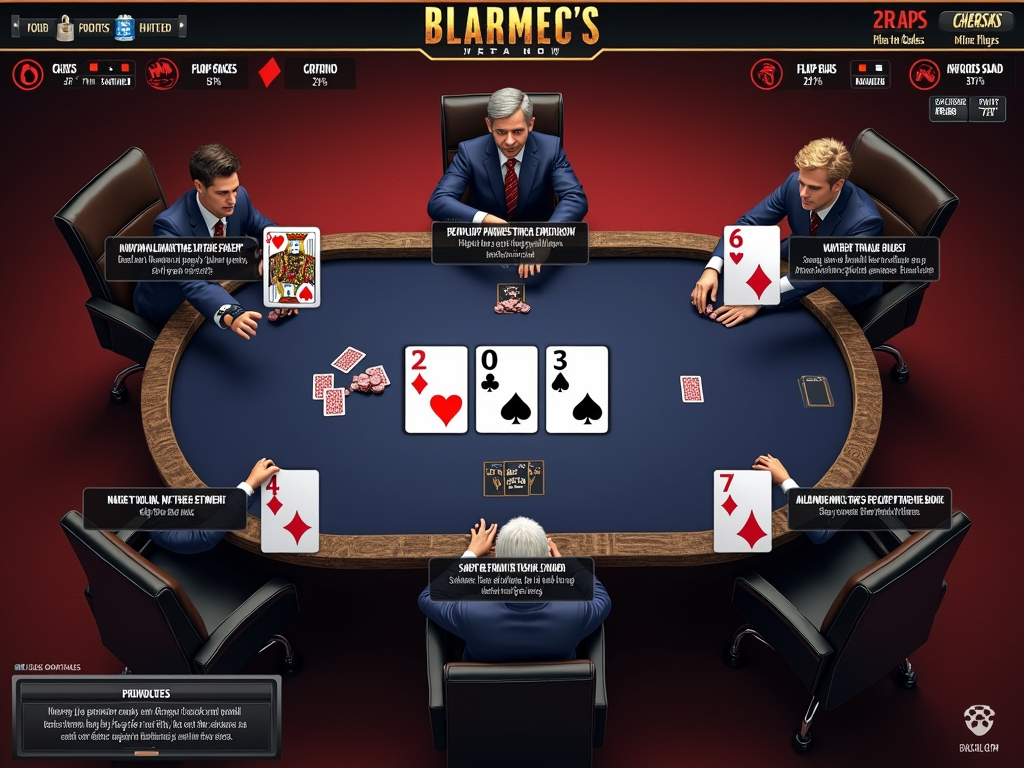Mastering Post-Flop Poker: Strategies for the Turn and River
Post-flop poker demands decisive action on the turn and river as pots increase and each decision carries more weight. I focus on specific betting patterns and position-based strategies to maximize profits during these crucial betting rounds.
Key Takeaways
- Turn play requires reducing continuation bet frequency to 40–60% while maintaining strategic pressure in favorable spots
- Position advantage becomes more critical on later streets, allowing better pot control and information gathering
- River decisions focus on showdown value and converting missed draws into profitable bluffing opportunities
- Mathematical concepts like pot odds and implied odds are essential for making profitable decisions
- Advanced betting tactics such as thin value bets, blocker bets, and probe bets help maximize profits in different scenarios
Turn Strategy: Applying Controlled Pressure
I cut down continuation betting frequency on the turn while still applying pressure when circumstances allow. Reducing this to about 40–60% helps avoid spewing chips, especially on bad boards or when facing resistance.
My position at the table impacts every decision – acting last gives me control over the pot size and allows me to gather vital information before committing further chips. This insight enables well-timed aggression or pot-control decisions, depending on the hand.
River Strategy: Value Extraction and Bluffs
River play focuses on extracting value from made hands and transforming busted draws into calculated bluffs. What’s important here is discernment based on the opponent’s range and past betting patterns.
Math guides my river choices through careful analysis of pot odds, implied odds, and expected value. The goal is to make profitable bets or folds depending on the likelihood of success versus the cost.
Specialized Betting Tactics
I employ several specific betting tactics based on board texture and opponent tendencies:
- Thin value bets capitalize on slight edges by targeting hands I beat but that may still call
- Blocker bets prevent opponents from making profitable large bluffs by leveraging sizing and hand strength
- Probe bets are used to test opponents’ strength after they’ve shown weakness in earlier streets
Adapting to Situations
The key lies in adapting these concepts based on each unique situation. Strong post-flop play requires balancing aggression with discipline and leveraging positional advantage. This creates a dynamic strategy that maximizes my edge in these critical betting rounds.
Making Big Decisions on the Turn
The turn represents a critical street in poker where I’ve found the largest average pot sizes develop and crucial decisions must be made. Each turn card can dramatically reshape the entire hand dynamic, requiring quick adjustments to strategy and careful consideration of betting lines.
Strategic Adaptations for Turn Play
Turn continuation betting needs a more selective approach compared to flop betting. I’ve learned to reduce my continuation betting frequency to 40-60% on the turn, stepping back from the more aggressive frequencies commonly used on the flop. This adjustment helps protect my overall strategy while maintaining pressure in the right spots.
Key turn cards demand special attention and often force strategic shifts:
- Aces dropping on the turn can reshape the entire hand, requiring a reassessment of relative hand strength
- A third suited card introduces new flush possibilities and typically requires betting frequency adjustments
- Board pairing cards change the nuts and create new full house possibilities
Position plays an amplified role on the turn, affecting how I structure my betting patterns. In position, I can better control pot size and gain valuable information from my opponent’s actions. Here’s my approach to mastering turn play in different positions:
- From in position: I maintain aggression on coordinated boards with strong hands and draws
- From out of position: I mix in more check-raises with strong hands to protect my checking range
- When facing aggression: I consider board texture changes before making big calls or folds
Double barreling decisions depend heavily on my opponent’s flop calling range and the specific turn card. I’ve found success by increasing my double barrel frequency on:
- Turn cards that hurt my opponent’s likely flop calling range
- High cards that give me additional backdoor possibilities
- Blank turns where my opponent’s range remains weak
The turn marks the point where pot odds and implied odds calculations become increasingly important. With the larger pot sizes, mistakes here prove especially costly, making it essential to stay focused on range advantages and positional dynamics when plotting my course of action.
From Drawing to Made Hands: River Strategy
The river card marks the final phase of decision-making in poker, where drawing hands reach their ultimate fate. At this point, all draws have either completed into strong hands or missed entirely, leaving no room for speculation about future potential.
Making the Most of River Situations
With fixed hand strengths on the river, I focus heavily on showdown value and identifying prime spots for bluffing. Failed draws often make perfect bluffing candidates since they have zero showdown value but can represent many strong hands that played similarly on previous streets.
Here are the key factors I consider when crafting my river strategy:
- Relative hand strength changes – A seemingly strong hand can become significantly weaker if the river completes obvious draws
- Bluffing frequency – I carefully select my bluffs based on my opponent’s likely holdings and calling ranges
- Position advantage – Acting last gives me more information and control over the final pot size
- Bet sizing – I adjust my bet amounts to maximize value from worse hands while protecting against bluffs
The concept of range merging plays a vital role in my river decision-making. By balancing value bets with strategically chosen bluffs, I create a cohesive betting range that’s difficult for opponents to counter. For example, when I hold a busted flush draw on a paired board, I can confidently bluff since my betting pattern matches how I’d play strong hands like sets or full houses.
Converting missed draws into profitable bluffs requires careful consideration of several factors. I pay close attention to my opponent’s tendencies, the board texture, and my betting story throughout the hand. By selecting spots where my range contains both strong hands and logical bluffs, I can master advanced poker strategies and maintain pressure on my opponents even when my draw fails to complete.
The river card’s impact on hand rankings can’t be understated. What might have been the best hand on the turn can become a marginal holding or even a bluff catcher after certain river cards. I’m particularly cautious when obvious draws complete or when the board pairs, as these situations often require a significant adjustment to my strategy.
Betting for thin value becomes increasingly important on the river since hands can no longer improve. I look for spots to extract value from slightly worse hands while being mindful of my opponent’s likely holdings and their propensity to call or fold in similar situations.

Position: Your Secret Weapon
Acting last in poker hands gives me a significant edge that many players don’t fully use to their advantage. I can watch my opponents’ actions unfold before making any decisions, which creates countless opportunities to outmaneuver them on the turn and river.
Key Position Advantages
When I’m sitting in position, I get to wield several powerful tools that help maximize profits and minimize losses. I can size my bets more precisely since I’ve already seen how my opponents have acted. This insight lets me extract maximum value with strong hands while keeping pot sizes manageable with marginal holdings.
Here are the critical benefits of playing in position post-flop:
- Better bluffing opportunities arise as I can spot weakness in opponents’ betting patterns
- Value betting becomes more profitable since I can adjust sizing based on opponents’ actions
- Pot control is simpler to maintain when acting last
- Defensive play improves through immediate access to opponent tendencies
- Risk management gets easier with real-time information about hand strength
Playing out of position demands a more careful approach. I find success by reducing my bluffing frequency and focusing on stronger hands that can withstand pressure. When out of position, I need to master advanced poker strategies to compensate for the positional disadvantage.
The turn and river are where position truly shines. Acting last lets me adapt my betting patterns instantly based on the story my opponents tell through their actions. I can widen my value betting range significantly, knowing I’ll have better control over the final pot size. This positional advantage often makes the difference between a winning and break-even session at the tables.
Being in position also helps me maintain better control over my stack. I can make more informed decisions about pot commitment since I’ve already seen my opponents’ actions. This information edge translates directly into better profitability in both cash games and tournaments.
Mathematics of Better Decisions
Essential Calculations for Profitable Play
Making smart poker decisions comes down to solid math. I’ve found that pot odds serve as the foundation for profitable play – they tell you if a call is mathematically justified. The calculation is straightforward: divide the amount you need to call by the total pot after your potential call. For example, if there’s $100 in the pot and your opponent bets $50, you’d need to call $50 to win $150 total, making your pot odds 1:3 or about 33%.
For quick equity estimates during hands, I rely on the Rule of 2 and 4. When I have two cards to come (flop to river), I multiply my number of outs by 4 to get my approximate equity percentage. With just one card to come, I multiply by 2. If I’m holding a flush draw with 9 outs on the turn, I can quickly calculate my equity at around 18%.
Advanced Mathematical Concepts
Implied odds add another layer to basic pot odds calculations, especially in deep-stacked games. I consider not just the current pot size, but also how much I might win if I hit my hand. However, reverse implied odds can trap players with drawing hands – that’s when you make your hand but still lose to a better one.
Here are key mathematical concepts I use to optimize my bluffing strategy:
- GTO bluffing frequency uses the formula: Risk/(Risk + Reward) to determine optimal bluffing rates
- Minimum Defense Frequency helps calculate how often I need to call to prevent opponents from profiting from bluffs
- Stack-to-pot ratios guide my decision-making, particularly in determining whether drawing hands are profitable
When playing online poker strategy, these mathematical tools become even more critical since I can’t rely on physical tells. By incorporating these calculations into my decision-making process, I create a solid foundation for profitable play that goes beyond mere intuition.
In high-pressure situations, having these mathematical frameworks helps me make rational choices rather than emotional ones. Instead of guessing, I can quickly assess whether a call, raise, or fold offers the best expected value based on concrete numbers.

Advanced Betting Tactics
Betting tactics in post-flop play need careful planning and precise execution. I’ve found that understanding various betting approaches can dramatically boost your win rate at the poker table, whether playing live or online.
Essential Betting Techniques
Value betting sits at the core of profitable poker, but there’s a crucial difference between standard value bets and thin value bets. I make thin value bets when I suspect my hand is only slightly ahead of my opponent’s calling range—think middle pair on a dry board. These bets typically use smaller sizings around 50% of the pot to get calls from weaker hands.
Here are the key betting moves you’ll want to add to your arsenal:
- Blocker bets: I use small bets (around 25–33% of the pot) to prevent larger bets from opponents and maintain pot control. This works well when I have showdown value but don’t want to face a big river bet.
- Probe bets: After the pre-flop aggressor checks back on an earlier street, I’ll often lead out with a probe bet. This helps me take control of the hand and gather information about my opponent’s holding.
- Float bets: I’ll call a bet on one street with the plan to take the pot away on later streets. This move works best in position against opponents who give up easily.
- Semi-bluffs: When holding drawing hands, I combine my immediate fold equity with the potential to make the best hand. Strong flush draws and straight draws make perfect semi-bluff candidates.
Bet sizing tells a story to my opponents. I stick to 50% pot bets when I want calls from marginal hands, while larger bets of 75% or more of the pot signal either very strong hands or bluffs. This polarized approach keeps opponents guessing and makes my betting patterns harder to exploit.
Let’s break down these concepts further. When I semi-bluff, I’m not just throwing money away on a draw—I’m building a pot for when I hit while maintaining fold equity. Similarly, blocker bets aren’t just small bets to save money; they’re strategic tools to control pot size and prevent opponents from making profitable large bets.
Probe betting requires careful board reading. I look for textures that likely missed my opponent’s range when deciding whether to lead out. This betting style works particularly well on boards that favor my perceived range over my opponent’s.

Tools for Improvement
Post-flop play demands sharp analysis and strategic thinking. I’ve found several essential tools that can boost your game and decision-making skills significantly.
Strategic Analysis Software
Equity calculators create the foundation for solid post-flop decisions. I rely on Equilab and PokerStove to break down hand ranges and calculate winning percentages in different scenarios. These tools help me visualize how my hand performs against my opponent’s likely holdings on the turn and river.
For deep strategic insights, poker solvers have changed how I approach complex situations. PioSOLVER and GTO+ create detailed models of optimal play, letting me study balanced strategies for tricky turn and river spots. I’ve noticed these tools excel at revealing counter-intuitive plays that I wouldn’t have considered otherwise.
Performance Tracking and Analysis
Here are the key tools I use to track and improve my poker performance:
- PokerTracker 4 and Hold’em Manager 3 for storing and analyzing hand histories
- Heads-Up Display (HUD) statistics for quick reads on opponents during play
- Database filters to study specific spots and patterns
- Hand review tools for post-session analysis
These tracking tools have transformed how I study my game. I can pinpoint leaks in my turn and river play by filtering for specific situations and reviewing the data. The HUD provides real-time stats that help me make better decisions against different player types.
Through database analysis, I can spot patterns in my post-flop decision-making. For instance, I might discover I’m too passive on turn cards that complete straight draws, or I’m over-bluffing on river spots against certain player types. This information lets me make targeted adjustments to my strategy.
By combining these tools with focused practice, I’ve created a systematic approach to improving my poker strategy and decision-making skills. Each session becomes a learning opportunity, with concrete data to guide my development rather than relying on gut feelings alone.
Remember that these tools support decision-making – they don’t replace it. I’ve learned to use them as guides while developing my own intuition and understanding of the game’s fundamentals.
Sources:
Ed Miller – The Course
Andrew Seidman – Easy Game
Jonathan Little Poker Coaching
Upswing Poker
Run It Once
Matthew Janda – Applications of No-Limit Hold’em





